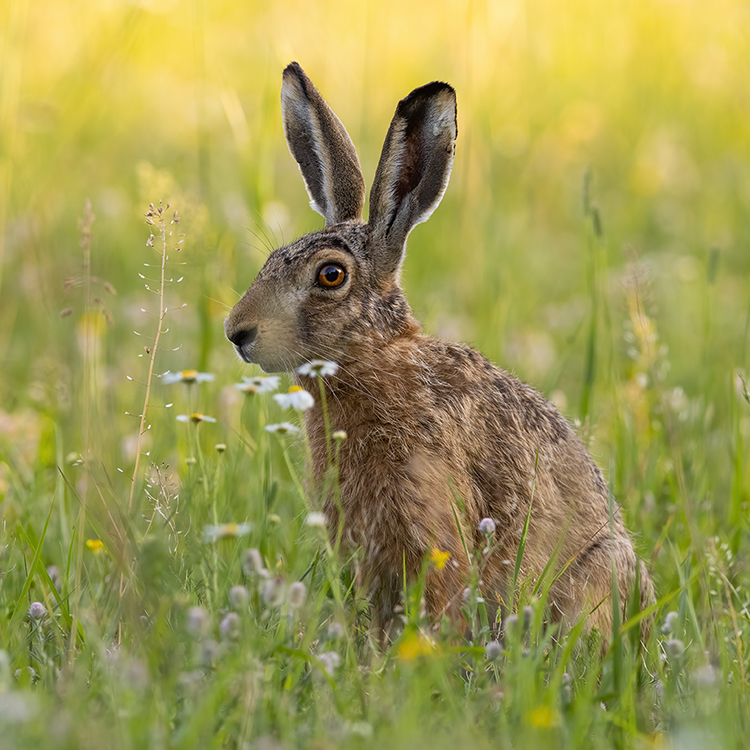Hares and harebells are both iconic species of our meadows that are inextricably linked with our agricultural heritage and our cultural landscape.

One of my favourite meadow mammals is the European brown hare (Lepus europaeus). Over the centuries we’ve woven a rich mythology around this enigmatic creature and it’s always enchanting to see them on an early morning walk. They’re an adaptable species that thrive in any landscape that is rich in broad-leaved herbs and grasses. Their wide range means they aren’t considered threatened on a global scale but can be in danger of local extinctions when agricultural practices and other land use changes deprive them of the species-rich meadows they depend on. This habitat loss often leads them to forage on arable crops instead, making them an agricultural pest.
Generally a nocturnal species, the moon gazing hare is an ancient archetype that appears in imagery wherever hares are found. However, they do change their normally secretive behaviour in spring when hormones are running rampant. Our fascination with the sudden appearance of hares boxing in broad daylight has also made a frequent subject for the arts. You’d think this was male hares duking it out for rights to the ladies, but more often its females batting away unwelcome males – or perhaps testing out their commitment to the chase. This spring frenzy is behind the saying ‘mad as a March hare’ – a character that made an appearance at the Mad Hatter’s tea party in Alice in Wonderland.
This combination of nocturnal habits and promiscuous spring mating behaviour has made the hare strongly associated with fertility and goddess archetypes since at least Ancient Greece. It is also one possible origin of – or at least a contributor to – the traditional Easter Bunny, which is often an Easter Hare in Europe.
Hares don’t dig burrows like rabbits, but nest in shallow depressions – called a form – in meadows. Their young, known as leverets, are soon up and about, expert at hiding by laying low but also soon able to run from predators. An adult hare can sprint at upwards of 40mph and their agility in the evasive zigzag is impressive. Hares are much larger than rabbits so their predators (other than humans) are mainly larger canids and felines and the largest birds of prey. To put their speed in context, a wolf can sprint at around 35 mph, so the hare is not an easy target in a straight race, but rather one that must be outsmarted. Speed is also the topic of Aesop’s fable of The Tortoise and the Hare – which goes to show that speed isn’t everything. But it has saved more than a few hares from an early demise!
In this design I’ve featured both brown hares and a few white mountain hares (Lepus timidus) scattered amongst the harebells (Campanula rotundifolia). The harebell is also known as the bluebell in Scotland and it’s Latin name rotundifolia refers to its round leaves. However, like the reputed shapeshifting abilities of the hare, the harebell has two shapes of leaf – round or heart-shaped basal leaves and elongated stem leaves. You can find both types throughout this pattern. In Britain you can find these blue flowers, referred to by Shakespeare as ‘The azured hare-bell’, in nutrient-poor meadows, heathlands and dunes from about July to November.


The harebell likely gets its name from the fact that it is found in places frequented by hares. However, some other names for this flower are witches bells or witch thimbles and its juices are reputed to have been used by witches to shapeshift into hares. This may well be due to the earlier association of hares with the goddess having been transferred to witchcraft in a Christianised worldview. Either way, in some regions the harebell is considered to be a flower of grief and bad luck that should not be pulled up. And to hear the ringing of the harebells is said to herald a gathering of faery folk. These are one of my favourite wildflowers – but I’ve never been lucky enough to hear them ring!
Image by Gary Rogers
Both the hare and the harebell are iconic species in our meadows with a rich tradition in storytelling and art that should be cherished every bit as much as the species themselves.

You can find this hares and harebells design in indigo, mint and buff in my Redbubble and Spoonflower shops. It’s available on fabric, wallpaper, household textiles, stationary, T-shirts and a host of other items to delight and inspire you.
Further reading
Read more about hares and agriculture: https://www.mammal.org.uk/2020/10/mammal-week-2020-arable-and-horticulture/
Harebells and bluebells in mythology: https://bardgarden.blogspot.com/2017/03/harebells-and-bluebells.html

